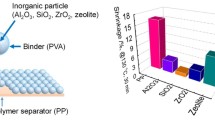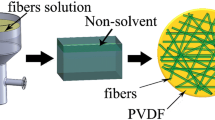Abstract
The occurrence of an internal short circuit caused by lithium dendrite puncturing the separators is a critical safety issue for lithium batteries. While the investigation of dendrite puncturing resistance of commercial polyolefin separators is well-established, nonwoven separators have received fewer relevant studies. Therefore, we assembled lithium-symmetric cells, lithium-sulfur batteries, and lithium-lithium iron phosphate batteries using three commercial nonwoven separators and a homemade micro-fibrillated cellulose nonwoven separator to verify the ability of the nonwoven separator to resist lithium dendrite penetration. The results reveal that even under low current densities, all four types of nonwoven separators are susceptible to dendrite puncturing, leading to both hard short circuits with significant voltage drops, as well as soft short circuits with charging currents or voltage fluctuations. Moreover, the impedance of lithium-symmetric cells is significantly reduced after short circuit, while the charge transfer resistance of lithium-sulfur batteries increases substantially after short circuit. Our findings provide valuable insights for the development of nonwoven separators for use in lithium metal batteries, highlighting the need for further reduction in pore size.






Similar content being viewed by others
Data availability
All data generated or analyzed during this study are included in this article.
References
Xie J, Lu YC (2020) A retrospective on lithium-ion batteries. Nat Commun 11:2499. https://doi.org/10.1038/s41467-020-16259-9
Arora P, Zhang ZM (2004) Battery separators. Chem Rev 104:4419–4462. https://doi.org/10.1021/cr020738u
Lin XK, Khosravinia K, Hu XS, Li J, Lu W (2021) Lithium plating mechanism, detection, and mitigation in lithium-ion batteries. Prog Energy Combust Sci 87. https://doi.org/10.1016/j.pecs.2021.100953
Hogrefe C, Waldmann T, Hölzle M, Wohlfahrt-Mehrens M (2023) Direct observation of internal short circuits by lithium dendrites in cross-sectional lithium-ion in situ full cells. J. Power Sources 556. https://doi.org/10.1016/j.jpowsour.2022.232391
Yasin G, Arif M, Mehtab T, Lu X, Yu DL, Muhammad N, Nazir MT, Song HH (2020) Understanding and suppression strategies toward stable Li metal anode for safe lithium batteries. Energy Storage Mater 25:644–678. https://doi.org/10.1016/j.ensm.2019.09.020
Zhang SS (2007) A review on the separators of liquid electrolyte Li-ion batteries. J Power Sources 164:351–364. https://doi.org/10.1016/j.jpowsour.2006.10.065
Lu DP, Shao YY, Lozano T, Bennett WD, Graff GL, Polzin B, Zhang JG, Engelhard MH, Saenz NT, Henderson WA, Bhattacharya P, Liu J, Xiao J (2015) Failure mechanism for fast-charged lithium metal batteries with liquid electrolytes. Adv Energy Mater 5. https://doi.org/10.1002/aenm.201400993
Jiao SH, Zheng JM, Li QY, Li X, Engelhard MH, Cao RG, Zhang JG, Xu W (2018) Behavior of lithium metal anodes under various capacity utilization and high current density in lithium metal batteries. Joule 2:110–124. https://doi.org/10.1016/j.joule.2017.10.007
An H, Roh Y, Jo Y, Lee H, Lim M, Lee M, Lee YM, Lee H (2022) Separator dependency on cycling stability of lithium metal batteries under practical conditions. Energy Environ Mater. https://doi.org/10.1002/eem2.12397
Bai P, Li J, Brushett FR, Bazant MZ (2016) Transition of lithium growth mechanisms in liquid electrolytes. Energy Environ Sci 9:3221–9. https://doi.org/10.1039/c6ee01674j
Bai P, Guo J, Wang M, Kushima A, Su L, Li J, Brushett FR, Bazant MZ (2018) Interactions between lithium growths and nanoporous ceramic separators. Joule 2:2434–49. https://doi.org/10.1016/j.joule.2018.08.018
Aguesse F, Manalastas W, Buannic L, Lopez Del Amo JM, Singh G, Llordes A, Kilner J (2017) Investigating the dendritic growth during full cell cycling of garnet electrolyte in direct contact with Li metal. ACS Appl Mater Interfaces 9:3808–3816. https://doi.org/10.1021/acsami.6b13925
Ping W, Wang C, Lin Z, Hitz E, Yang C, Wang H, Hu L (2020) Reversible short-circuit behaviors in garnet-based solid-state batteries. Adv Energy Mater 10. https://doi.org/10.1002/aenm.202000702
Sun H, Liu Q, Chen J, Li Y, Ye H, Zhao J, Geng L, Dai Q, Yang T, Li H, Wang Z, Zhang L, Tang Y, Huang J (2021) In situ visualization of lithium penetration through solid electrolyte and dead lithium dynamics in solid-state lithium metal batteries. ACS Nano. https://doi.org/10.1021/acsnano.1c04864
Liu H, Cheng X-B, Huang J-Q, Yuan H, Lu Y, Yan C, Zhu G-L, Xu R, Zhao C-Z, Hou L-P, He C, Kaskel S, Zhang Q (2020) Controlling dendrite growth in solid-state electrolytes. ACS Energy Lett 5:833–43. https://doi.org/10.1021/acsenergylett.9b02660
Kritzer P, Cook JA (2007) Nonwovens as separators for alkaline batteries - an overview. J Electrochem Soc 154:A481–A494. https://doi.org/10.1149/1.2711064
Wang Y, Luo JR, Chen L, Long J, Hu J, Meng L (2021) Effect of fibrillated fiber morphology on properties of paper-based separators for lithium-ion battery applications. J. Power Sources 482. https://doi.org/10.1016/j.jpowsour.2020.228899
Hantel MM, Armstrong MJ, Darosa F, L’abee R (2017) Characterization of tortuosity in polyetherimide membranes based on Gurley and electrochemical impedance Spectroscopy. J Electrochem Soc 164:A334–A339. https://doi.org/10.1149/2.1071702jes
He YT, Fan WD, Zhang YH, Wang ZH, Li XF, Liu ZG, Lu Z (2020) Understanding the relationships between morphology, solid electrolyte interphase composition, and coulombic efficiency of lithium metal. ACS Appl Mater Interfaces 12:22268–22277. https://doi.org/10.1021/acsami.0c00789
Wood KN, Kazyak E, Chadwick AF, Chen KH, Zhang JG, Thornton K, Dasgupta NP (2016) Dendrites and pits: untangling the complex behavior of lithium metal anodes through operando video microscopy. ACS Cent Sci 2:790–801. https://doi.org/10.1021/acscentsci.6b00260
Kang DM, Hart N, Xiao MY, Lemmon JP (2021) Short circuit of symmetrical Li/Li cell in Li metal anode research. Acta Phys -Chim Sin 37. https://doi.org/10.3866/pku.Whxb202008013
Li YJ, Zhang G, Chen B, Zhao W, Sha LT, Wang D, Yu J, Shi SQ (2022) Understanding the separator pore size inhibition effect on lithium dendrite <i>via</i> phase-field simulations. Chin Chem Lett 33:3287–3290. https://doi.org/10.1016/j.cclet.2022.03.065
Kushima A, So KP, Su C, Bai P, Kuriyama N, Maebashi T, Fujiwara Y, Bazant MZ, Li J (2017) Liquid cell transmission electron microscopy observation of lithium metal growth and dissolution: root growth, dead lithium and lithium flotsams. Nano Energy 32:271–279. https://doi.org/10.1016/j.nanoen.2016.12.001
Li Y, Long J, Liang Y, Hu J (2023) Lithium dendrites puncturing separator induced galvanostatic charge/discharge test problem in Li-symmetric cells. Ionics. https://doi.org/10.1007/s11581-023-05223-4
Rosso M, Brissot C, Teyssot A, Dollé M, Sannier L, Tarascon J-M, Bouchet R, Lascaud S (2006) Dendrite short-circuit and fuse effect on Li/polymer/Li cells. Electrochim Acta 51:5334–40. https://doi.org/10.1016/j.electacta.2006.02.004
Lu Y, Tu Z, Archer LA (2014) Stable lithium electrodeposition in liquid and nanoporous solid electrolytes. Nat Mater 13:961–969. https://doi.org/10.1038/nmat4041
Lu Y, Zhao C-Z, Yuan H, Cheng X-B, Huang J-Q, Zhang Q (2021) Critical current density in solid-state lithium metal batteries: mechanism, influences, and strategies. Adv Funct Mater 31. https://doi.org/10.1002/adfm.202009925
Li Y, Zhang G, Chen B, Zhao W, Sha L, Wang D, Yu J, Shi S (2022) Understanding the separator pore size inhibition effect on lithium dendrite via phase-field simulations. Chin Chem Lett 33:3287–90. https://doi.org/10.1016/j.cclet.2022.03.065
Canas NA, Hirose K, Pascucci B, Wagner N, Friedrich KA, Hiesgen R (2013) Investigations of lithium–sulfur batteries using electrochemical impedance spectroscopy. Electrochim Acta 97:42–51. https://doi.org/10.1016/j.electacta.2013.02.101
Deng Z, Zhang Z, Lai Y, Liu J, Li J, Liu Y (2013) Electrochemical impedance spectroscopy study of a lithium/sulfur battery: modeling and analysis of capacity fading. J Electrochem Soc 160:A553–A8. https://doi.org/10.1149/2.026304jes
Drvarič Talian S, Moškon J, Dominko R, Gaberšček M (2021) The pitfalls and opportunities of impedance spectroscopy of lithium sulfur batteries. Mater Interfaces, Adv. https://doi.org/10.1002/admi.202101116
Waluś S, Barchasz C, Bouchet R, Alloin F (2020) Electrochemical impedance spectroscopy study of lithium–sulfur batteries: useful technique to reveal the Li/S electrochemical mechanism. Electrochim Acta 359. https://doi.org/10.1016/j.electacta.2020.136944
Drvarič Talian S, Kapun G, Moškon J, Vizintin A, Randon-Vitanova A, Dominko R, Gaberšček M (2019) Which process limits the operation of a Li–S system? Chem Mater 31:9012–23. https://doi.org/10.1021/acs.chemmater.9b03255
Gaberscek M, Moskon J, Erjavec B, Dominko R, Jamnik J (2008) The importance of interphase contacts in Li ion electrodes: the meaning of the high-frequency impedance arc. Electrochem Solid-State Lett 11:A170–A174. https://doi.org/10.1149/1.2964220
Atebamba JM, Moskon J, Pejovnik S, Gaberscek M (2010) On the interpretation of measured impedance spectra of insertion cathodes for lithium-ion batteries. J Electrochem Soc 157:A1218–A1228. https://doi.org/10.1149/1.3489353
Zhang T, Yang Z, Wang L, Zhao X, Zhuang QC (2019) Electrochemical properties of olivine-type LiFePO4/C cathode material for lithium ion batteries. Int J Electrochem Sci 13:8322–37. https://doi.org/10.20964/2018.09.30
Zhuang QC, Yang Z, Zhang L, Cui YH (2020) Research progress on diagnosis of electrochemical impedance spectroscopy in lithium ion batteries. Prog Chem 32:761–791. https://doi.org/10.7536/pc191116
Zhu JD, Yanilmaz M, Fu K, Chen C, Lu Y, Ge YQ, Kim D, Zhang XW (2016) Understanding glass fiber membrane used as a novel separator for lithium-sulfur batteries. J Membr Sci 504:89–96. https://doi.org/10.1016/j.memsci.2016.01.020
Funding
This work was supported by the Fundamental Research Funds for the Central Universities (2022ZYGXZR112).
Author information
Authors and Affiliations
Contributions
Yao Li: Data collection, analysis and processing; Writing—Original Draft.
Jin Long: Writing—Review & Editing, Supervision.
Zhiyuan Xiong: Writing—Review & Editing, Supervision.
Yun Liang: Supervision.
Jian Hu: Supervision.
Corresponding authors
Ethics declarations
Ethics approval and consent to participate
Not applicable.
Competing interests
The authors declare no competing interests.
Additional information
Publisher's Note
Springer Nature remains neutral with regard to jurisdictional claims in published maps and institutional affiliations.
Supplementary Information
Below is the link to the electronic supplementary material.
Rights and permissions
Springer Nature or its licensor (e.g. a society or other partner) holds exclusive rights to this article under a publishing agreement with the author(s) or other rightsholder(s); author self-archiving of the accepted manuscript version of this article is solely governed by the terms of such publishing agreement and applicable law.
About this article
Cite this article
Li, Y., Long, J., Xiong, Z. et al. Study on the lithium dendrite puncturing resistance of nonwoven separators. Ionics 30, 2105–2117 (2024). https://doi.org/10.1007/s11581-024-05435-2
Received:
Revised:
Accepted:
Published:
Issue Date:
DOI: https://doi.org/10.1007/s11581-024-05435-2




